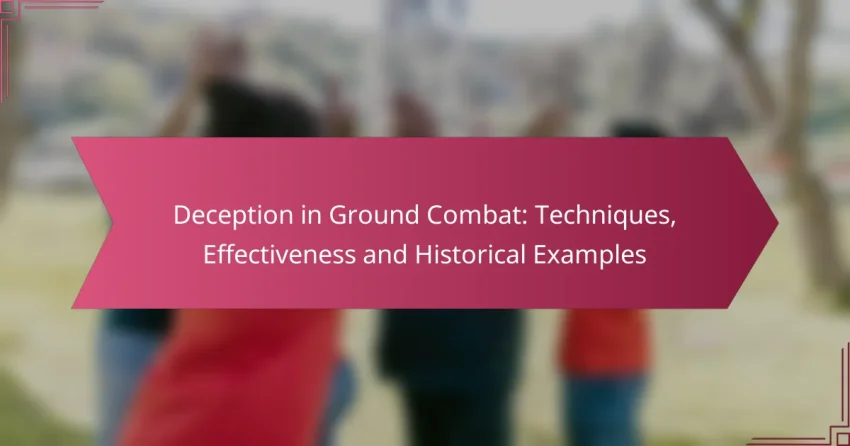Deception in ground combat encompasses a range of strategies aimed at misleading the enemy about one’s true intentions and capabilities. By creating confusion and uncertainty, these techniques can disrupt enemy operations and provide significant tactical advantages. Historical examples reveal how effective deception has altered the course of battles, showcasing the critical role of misinformation in military strategy.
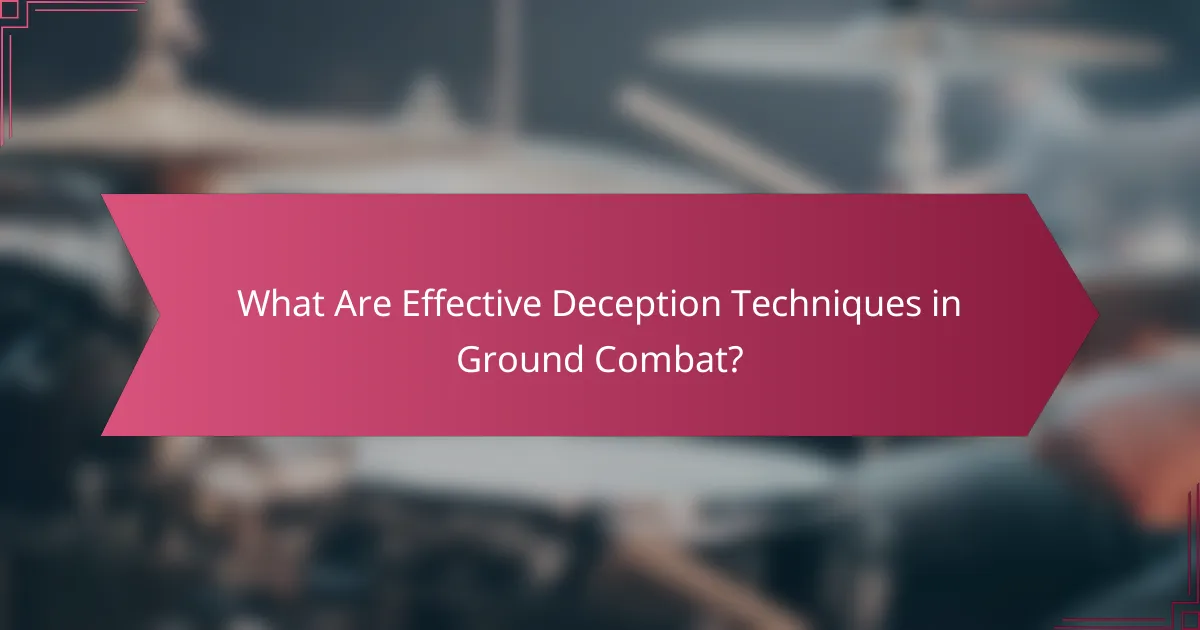
What Are Effective Deception Techniques in Ground Combat?
Effective deception techniques in ground combat are strategies designed to mislead the enemy regarding one’s intentions, capabilities, or movements. These techniques can significantly enhance operational effectiveness by creating confusion and uncertainty in opposing forces.
Camouflage and Concealment
Camouflage and concealment involve using materials and techniques to blend military assets into their surroundings, making them less visible to the enemy. This can include natural foliage, specially designed patterns, or even digital means like thermal masking.
Effective camouflage requires understanding the environment and the visual spectrum, including colors, textures, and movement. For example, using earth tones in a forested area can reduce visibility, while urban settings may require different patterns and materials.
Decoys and Misdirection
Decoys and misdirection are tactics that use fake targets or signals to divert enemy attention away from actual forces. This can involve inflatable tanks, electronic signals, or even misleading troop movements.
When employing decoys, it’s crucial to ensure they are convincing enough to draw enemy fire or reconnaissance. For instance, placing decoys in a location that suggests a strategic advantage can lead the enemy to misallocate resources.
Electronic Warfare Tactics
Electronic warfare tactics involve disrupting or deceiving enemy electronic systems, such as radar and communication networks. This can include jamming signals or using spoofing techniques to mislead enemy sensors.
Implementing electronic warfare requires a deep understanding of the enemy’s technology and vulnerabilities. For example, using low-power jamming can effectively disrupt communications without revealing one’s own position.
Psychological Operations
Psychological operations aim to influence the perceptions and behaviors of enemy forces and civilian populations. This can involve propaganda, misinformation, or creating a false sense of security or urgency.
Successful psychological operations often rely on understanding cultural contexts and communication channels. For instance, disseminating false information through social media can lead to confusion and panic among enemy troops.
Feigned Retreats
Feigned retreats are tactics where forces pretend to withdraw to lure the enemy into a vulnerable position. This can create opportunities for counterattacks or ambushes.
Executing a feigned retreat requires careful planning and coordination to ensure that the enemy is convinced of the withdrawal. Timing and terrain play critical roles; a sudden counteroffensive can exploit the enemy’s overextension effectively.
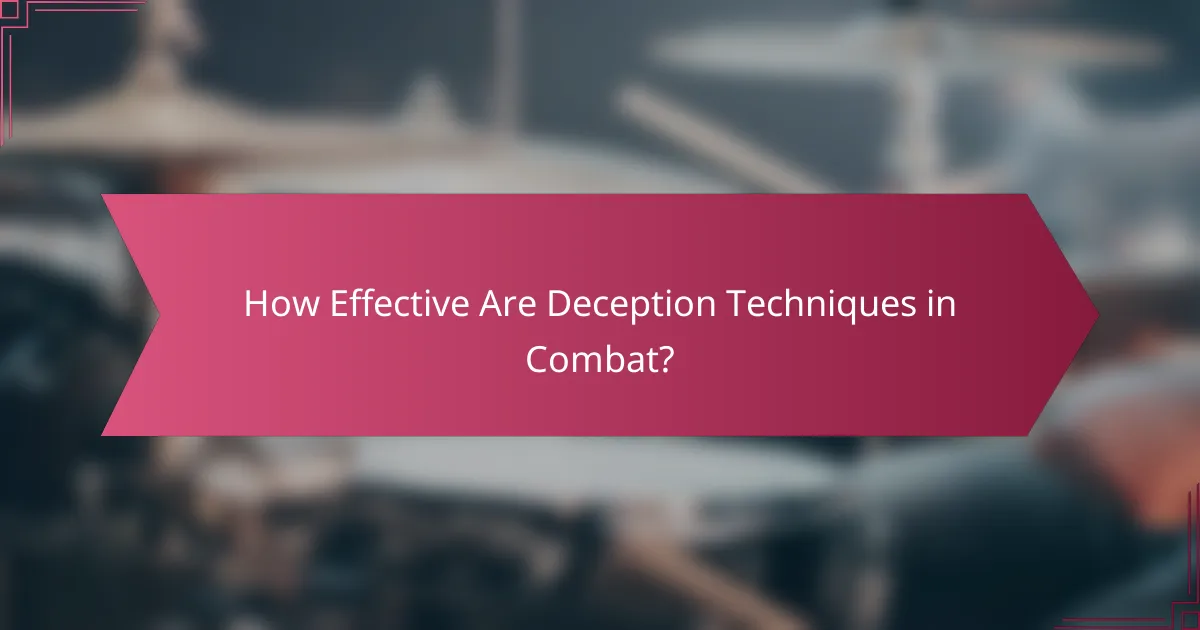
How Effective Are Deception Techniques in Combat?
Deception techniques in combat can significantly disrupt enemy operations and decision-making, often leading to tactical advantages. Their effectiveness hinges on the execution, context, and the adversary’s ability to discern truth from deception.
Impact on Enemy Decision-Making
Deception techniques can create confusion and uncertainty in enemy ranks, leading to delayed or incorrect decisions. By manipulating the enemy’s perception of the battlefield, forces can exploit vulnerabilities and capitalize on miscalculations.
For instance, feigned retreats or false signals can mislead opponents about troop movements or intentions, prompting them to commit resources inappropriately. This can result in tactical advantages, such as ambush opportunities or the ability to reposition forces without detection.
Historical Success Rates
Historically, deception techniques have shown varied success rates depending on the scenario and execution. In many cases, well-planned deceptions have led to significant operational successes, with estimates suggesting that effective deception can improve operational outcomes by 20-30% in certain contexts.
However, the success of these techniques often relies on the enemy’s level of awareness and adaptability. Forces that are trained to recognize and counter deception may mitigate its effectiveness, highlighting the importance of continuous adaptation in tactics.
Case Studies of Effectiveness
One notable case of effective deception is Operation Fortitude during World War II, which misled the Germans about the location of the D-Day invasion. By creating a fictitious army and using fake equipment, Allied forces successfully diverted German attention away from Normandy.
Another example is the use of decoys in the Gulf War, where coalition forces employed inflatable tanks and aircraft to mislead Iraqi forces about troop concentrations. These tactics contributed to the rapid success of coalition operations, showcasing the practical application of deception in modern warfare.
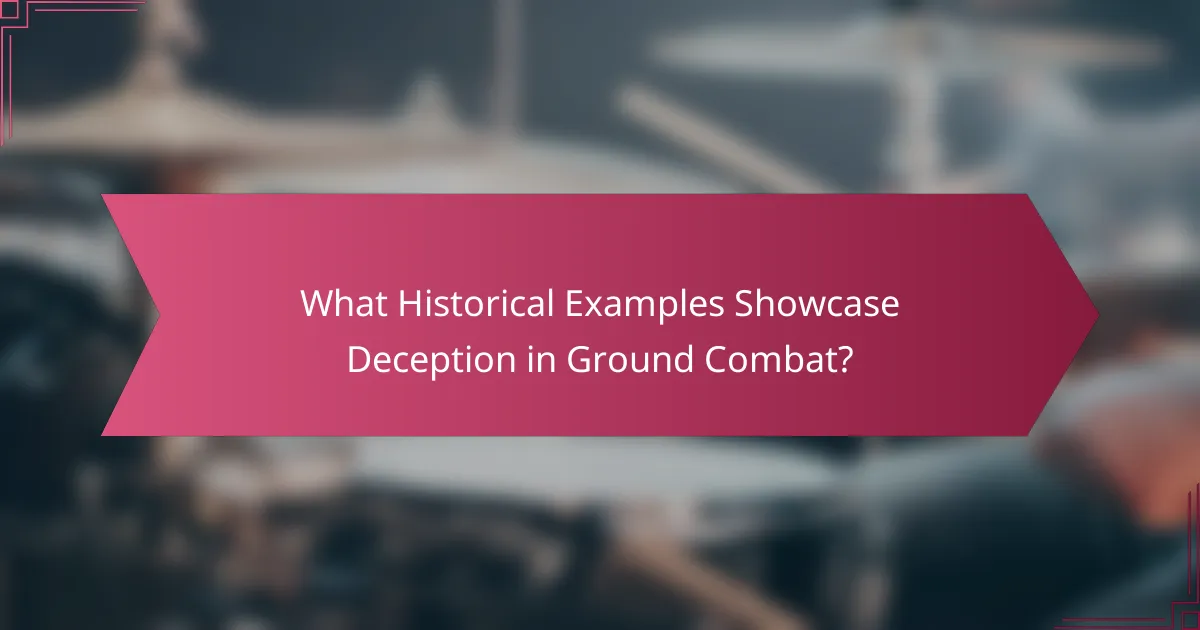
What Historical Examples Showcase Deception in Ground Combat?
Several historical examples illustrate the effective use of deception in ground combat, highlighting strategies that misled opponents and altered the course of battles. These instances demonstrate how misinformation and tactical maneuvers can create significant advantages on the battlefield.
Battle of Normandy (D-Day)
The Battle of Normandy, commonly known as D-Day, was marked by extensive deception tactics employed by the Allies. Prior to the invasion in June 1944, the Allies created a false sense of a larger invasion force through misleading radio transmissions and the deployment of dummy tanks and aircraft.
This deception led German forces to misallocate their resources, believing that the main assault would occur at Pas de Calais instead of the actual landing sites in Normandy. The success of this operation was crucial in establishing a foothold in Europe.
Operation Fortitude
Operation Fortitude was a key component of the broader deception strategy leading up to D-Day. It involved creating a fictitious army group, the First United States Army Group (FUSAG), supposedly stationed in England, poised to invade at Calais.
Through fake radio traffic, deceptive movements of troops, and even the use of inflatable tanks, the Allies successfully convinced the Germans that Calais was the primary target. This diversion played a significant role in the success of the Normandy landings by drawing German defenses away from the actual invasion area.
Battle of Stalingrad
The Battle of Stalingrad showcased deception through the use of feigned retreats and ambush tactics by Soviet forces. As German troops advanced, the Soviets employed a strategy of withdrawing in a controlled manner, luring the Germans deeper into the city.
This tactic allowed Soviet forces to regroup and launch counterattacks, ultimately encircling and defeating the German Sixth Army. The successful use of deception in Stalingrad was pivotal in shifting the momentum of World War II in favor of the Allies.
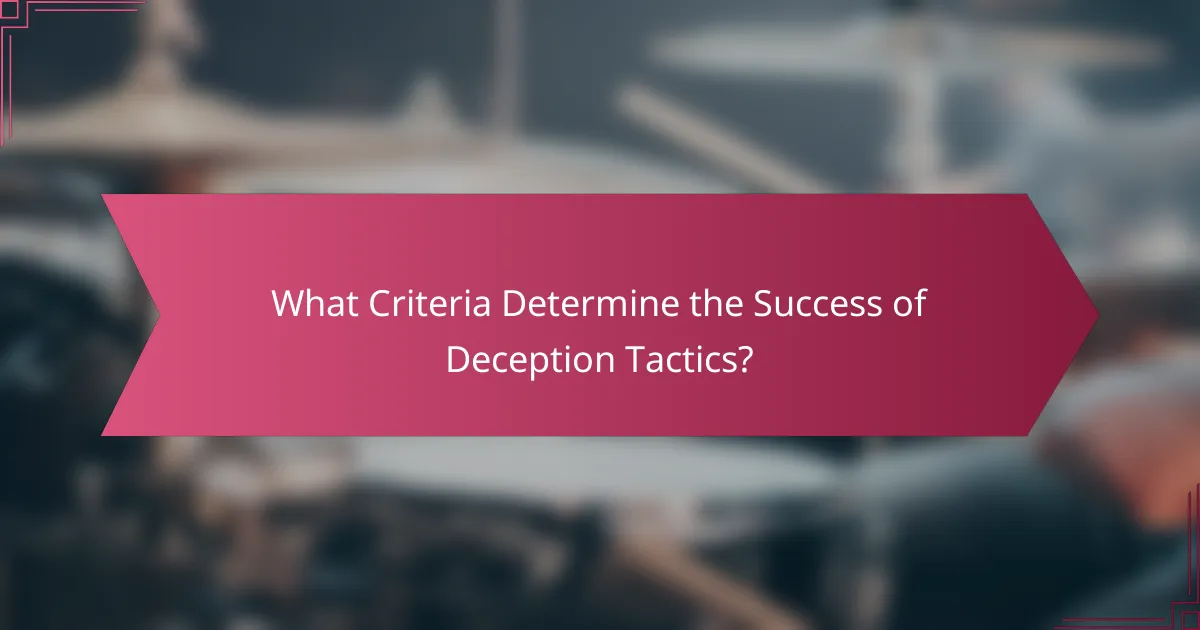
What Criteria Determine the Success of Deception Tactics?
The success of deception tactics in ground combat hinges on several key criteria, including understanding enemy psychology, environmental factors, and the timing and execution of the deception. Each of these elements plays a crucial role in how effectively a deception tactic can mislead the adversary and achieve strategic objectives.
Understanding Enemy Psychology
Effective deception tactics rely heavily on a deep understanding of enemy psychology. Knowing how the opponent thinks, reacts, and anticipates actions can help in crafting misleading scenarios that exploit their biases and expectations. For instance, if an enemy expects a frontal assault, a feigned retreat might lead them to overextend their forces.
To enhance the effectiveness of deception, military planners should consider creating false narratives or signals that align with the enemy’s preconceived notions. This can involve using misinformation through various channels, such as electronic warfare or psychological operations, to shape the enemy’s perception of the battlefield.
Environmental Factors
The environment plays a significant role in the success of deception tactics. Terrain, weather, and visibility can all influence how a deception is perceived and executed. For example, dense forests or urban settings can provide cover for deceptive maneuvers, while open fields may expose them to enemy observation.
Additionally, understanding local conditions, such as seasonal weather patterns, can help in planning deceptions that are more likely to succeed. For instance, conducting operations during foggy conditions can obscure movements and enhance the likelihood of misleading the enemy.
Timing and Execution
Timing and execution are critical components of successful deception tactics. A well-timed deception can catch the enemy off guard, while poor timing can render the tactic ineffective. It is essential to synchronize deceptive actions with real operations to create confusion and mislead the enemy about intentions.
Military leaders should develop a clear timeline for executing deception, ensuring that it aligns with operational goals. Regular assessments of the situation can help in adjusting tactics as needed, maintaining the element of surprise and maximizing the impact of the deception.
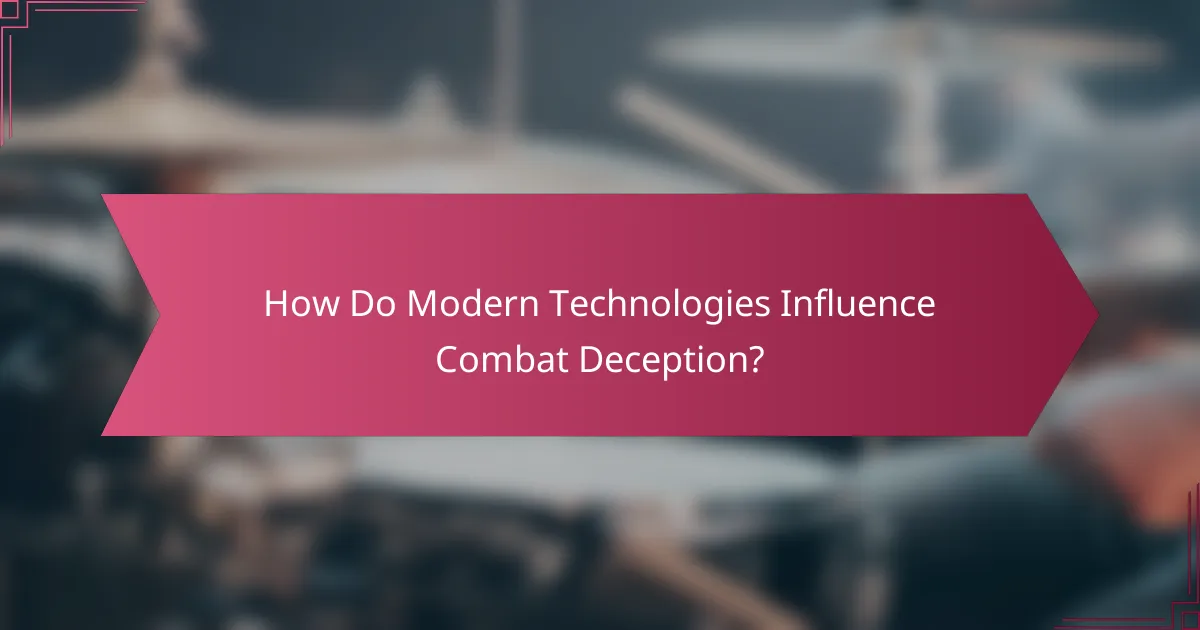
How Do Modern Technologies Influence Combat Deception?
Modern technologies significantly enhance combat deception by providing advanced tools for misdirection and manipulation. These innovations allow military forces to create false narratives and confuse adversaries, ultimately gaining a tactical advantage on the battlefield.
Use of Drones for Misdirection
Drones play a crucial role in modern combat deception by creating diversions and misleading enemy forces. For instance, a swarm of drones can simulate a larger troop movement, drawing attention away from the actual location of military assets. This tactic can effectively mislead enemy surveillance and targeting systems.
Additionally, drones equipped with advanced imaging and electronic warfare capabilities can disrupt enemy communications and provide false data. By employing drones in this manner, military planners can create a layered approach to deception, complicating the enemy’s decision-making process.
Cyber Warfare and Information Manipulation
Cyber warfare has transformed the landscape of combat deception by enabling the manipulation of information on a large scale. Through hacking and misinformation campaigns, military forces can create confusion and sow distrust among enemy ranks. This can involve disseminating false intelligence or altering data to mislead adversaries about troop movements or capabilities.
Moreover, social media platforms are often exploited to spread disinformation rapidly. By crafting narratives that align with their strategic objectives, military forces can influence public perception and enemy morale. Effective cyber deception requires a deep understanding of the target audience and the channels they use for information.
